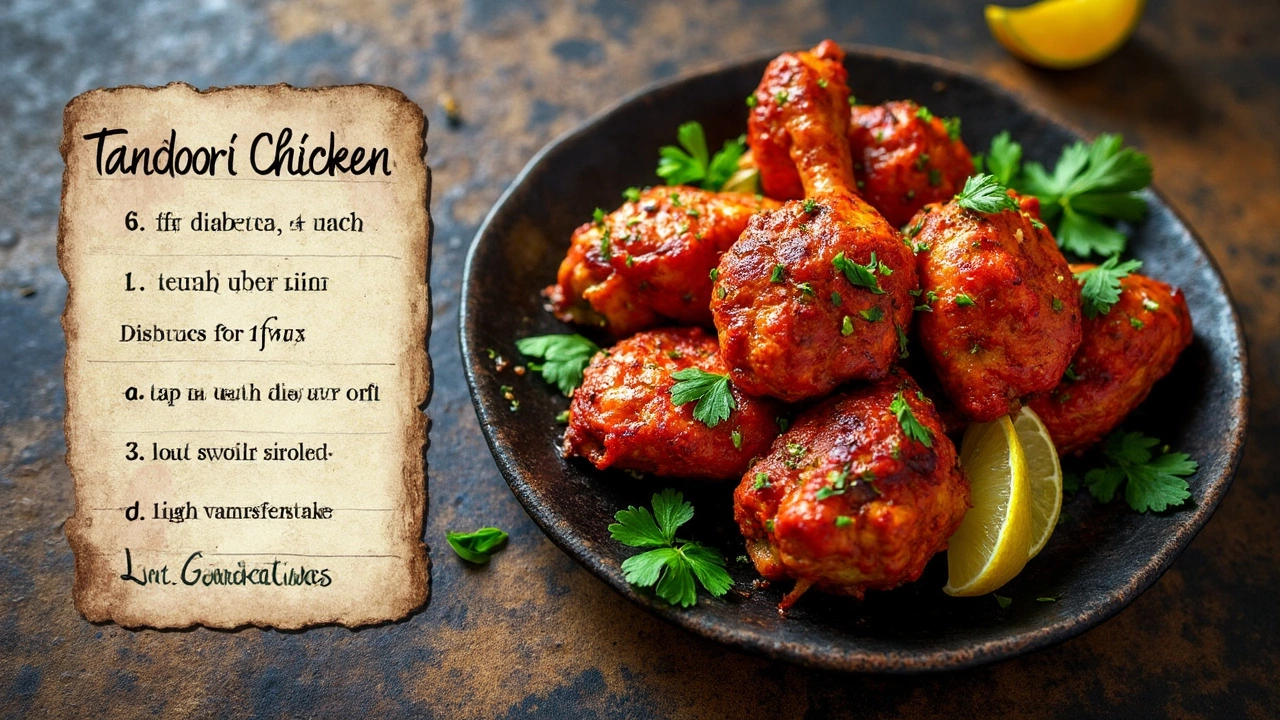Choosing the right kind of chicken can make all the difference if you're managing diabetes. You might be wondering whether tandoori chicken fits into your diet. Spoiler alert: it can be a delicious, diabetic-friendly option!
Why chicken, specifically? Well, it's lean, packed with protein, and can help maintain stable blood sugar levels. But not all chicken is created equal. When it comes to preparing tandoori chicken, picking the right cuts—think skinless, boneless breasts or thighs—can help keep things light and healthy.
Spices used in tandoori like turmeric, cumin, and coriander aren’t just about flavor; they come with their own health perks. For instance, turmeric is known for its anti-inflammatory properties. So, not only is tandoori chicken a tasty choice, but it can also be part of a balanced and nutritious diet for diabetics.
- Understanding Diabetes and Diet
- Benefits of Chicken for Diabetics
- Tandoori Chicken: A Flavorful Option
- Choosing the Right Chicken Cuts
- Practical Cooking Tips
Understanding Diabetes and Diet
When you're living with diabetes, diet becomes a huge part of your daily life. Blood sugar control is the name of the game, and what you eat can directly impact your levels. So, figuring out what foods help in keeping those levels stable is key.
The primary aim for diabetics is to manage carbohydrate intake since carbs have a direct impact on blood sugar. This doesn't mean ditching carbs entirely but rather choosing smart, healthy carbs such as whole grains, fruits, and vegetables.
Protein, like that found in chicken for diabetics, plays an essential role. It helps in maintaining muscle mass and, importantly, doesn't cause spikes in blood sugar levels. This makes chicken a great component of a diabetic-friendly diet.
Fat matters too, but opting for healthy fats can aid in weight management, which is often a critical part of diabetes care. Think avocados, nuts, and olive oil. While choosing chicken for diabetics, going for skinless cuts can keep the bad fats in check.
- Monitor Portions: Keeping an eye on portion sizes is as crucial as the food choices themselves.
- Balance is Key: Combining protein, carbs, and fats in moderation provides a more sustained energy release.
- Low Glycemic Index (GI) Choices: Opt for foods with a low GI to ensure steady release of sugar into the blood.
Understanding how different foods impact your body is empowering. By making informed choices, like including diabetic-friendly chicken recipes in your meals, you can enjoy delicious food while managing your condition effectively.
Benefits of Chicken for Diabetics
Chicken is pretty much a top choice when it comes to keeping things healthy and tasty for folks with diabetes. Why is that? Let’s break it down.
First up, chicken is lean and packed with protein, which is crucial for muscle building and repair. For someone with diabetes, protein plays a big role in keeping blood sugar levels steady. When you eat protein, it takes longer to digest compared to carbs, so it helps you feel full longer and prevents spikes in your blood sugar.
Another great thing about chicken is its versatility. You can do a lot with it—whether that's grilling, baking, or in our case, making delicious tandoori chicken. Just be sure to remove the skin where most of the saturated fat hides, especially if you're choosing thighs or other cuts.
Plus, chicken is lower in calories, making it easier to maintain a healthy weight, which is important in diabetes management. Keeping an eye on your weight can help improve insulin sensitivity.
Here's a quick nutritional peek:
| Chicken Cut | Calories | Protein |
|---|---|---|
| Skinless Chicken Breast (100g) | 165 | 31g |
| Skinless Chicken Thigh (100g) | 209 | 26g |
These numbers can help you make smart choices depending on your dietary goals. Remember, how you cook is just as important. Lean cooking methods like grilling are best for keeping calories and unhealthy fats in check.
So, while chicken for diabetics isn’t just drumsticks and wings, it sure does offer a tasty, filling way to manage health without feeling deprived.

Tandoori Chicken: A Flavorful Option
If you're looking for a meal that’s bursting with flavor and still diabetes-friendly, you can't go wrong with tandoori chicken. It's a dish that naturally brings together a mix of spices that not only boost taste but also offer health benefits.
The traditional marinade for tandoori chicken includes yogurt, which is a good source of protein and calcium. It helps tenderize the chicken, making it juicy and flavorful without the need for excess oil or butter. Plus, if you're keeping an eye on blood sugar, yogurt can have a moderate impact, especially when it’s unsweetened.
Spices are where the magic really happens. Each spice plays a role: turmeric adds color and has anti-inflammatory properties; cumin can aid digestion; and garlic is known for its antioxidant qualities. These ingredients keep the dish lively, without adding sugar or unhealthy fats that could disrupt a diabetic diet.
For those curious about nutritional content, here's a quick peek into how a serving might look:
| Component | Nutritional Value |
|---|---|
| Calories | 150 kcal |
| Protein | 26g |
| Fat | 4g |
| Carbohydrates | 3g |
Preparing tandoori chicken at home gives you control. You can choose skinless, boneless pieces to cut down on fat. Also, the grilling process—usually done on high heat—doesn't require any frying, making it healthier than other cooking methods.
When planning meals, it's helpful to remember that balance is key. Tandoori chicken pairs well with whole grains like brown rice or whole wheat naan and a side of veggies for a complete, diabetes-friendly dinner.
Choosing the Right Chicken Cuts
When you're keeping an eye on your blood sugar, opting for the right chicken cuts can be a game-changer in your diet. So, which ones should be gracing your plates more often? Let's break it down.
First off, chicken breasts are a top pick for a reason. They're low in fat, high in protein, and easily absorb the rich spices of a tandoori chicken marinade. This means you're getting flavor without unnecessary calories or carbs.
Yet, breasts aren't your only option. Chicken thighs, especially when going skinless, provide a juicier alternative with a bit more natural fat. This can actually help with satiety, which is important when you're managing diabetes. Just trim the visible fat and enjoy the savory goodness.
- Skinless Breasts - Lean, high in protein, perfect for low-calorie meals.
- Skinless Thighs - Juicier, moderate in calories, ideal for rich flavor profiles.
Now, if you're cooking for the whole family or just want variety, a mix of these cuts can bring balance to your meal. Remember to keep the portion sizes in check—about 3-4 ounces per serving is a good benchmark.
| Cut | Calories (per 100g) | Protein |
|---|---|---|
| Skinless Breast | 165 | 31g |
| Skinless Thigh | 209 | 26g |
So next time you whip up some tandoori chicken, pick your cuts accordingly. Your taste buds and your health will thank you!

Practical Cooking Tips
Cooking tandoori chicken at home can be simple and rewarding, not to mention a healthier option than many takeout alternatives. Here are some practical tips to ensure your dish is both delicious and diabetic-friendly.
Firstly, marination is key. A good marinade not only infuses flavor but also tenderizes the meat. Unlike store-bought options that can be high in sugar and preservatives, making your own lets you control the ingredients. Use plain yogurt as the base, as it adds creaminess without unnecessary carbs. Mix in spices like turmeric, cumin, and coriander for authentic taste and health benefits.
When cooking, grilling is your best friend. It reduces the need for added fats. Preheat your grill to medium-high to ensure the chicken cooks evenly. If you don't have a grill, baking is a great alternative. Preheat your oven to 200°C (about 400°F) and bake the marinated chicken for roughly 25-30 minutes until it reaches an internal temperature of 74°C (165°F).
- Choose skinless chicken breasts or thighs to cut down on saturated fats, which can help in managing cholesterol levels.
- Avoid adding salt to your marinade. Instead, rely on your spice mix to bring out the flavors.
- Consider using a food thermometer to ensure your chicken is cooked through without overcooking, which can dry it out.
Lastly, side dishes can make a big difference. Pair your tandoori chicken with a side of roasted vegetables or a green salad instead of carbohydrate-heavy options like naan or rice. This keeps the meal balanced and supportive of stable blood sugar levels.
By making subtle tweaks and smart choices, tandoori chicken can easily fit into a diabetic-friendly diet, providing rich flavors without compromising on health.
